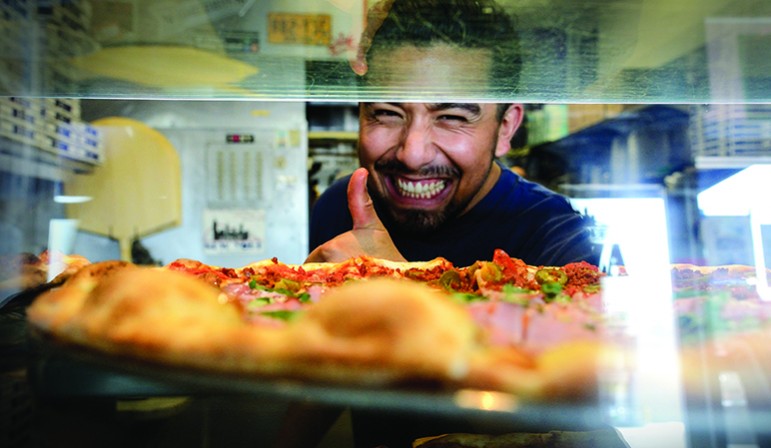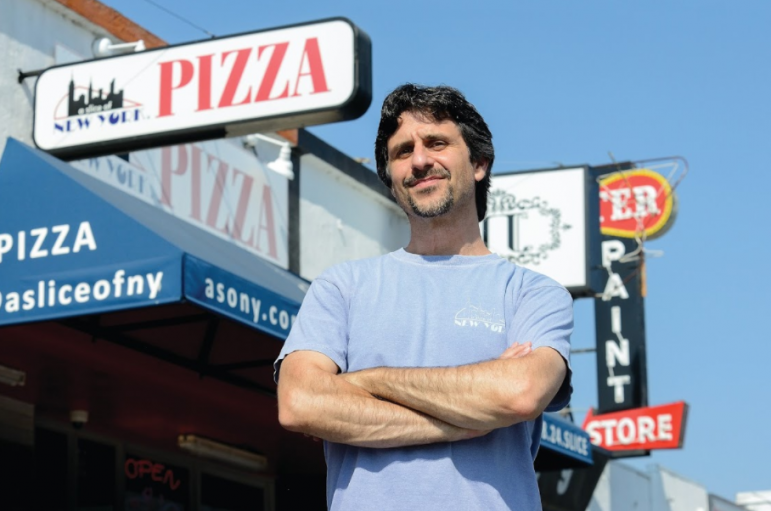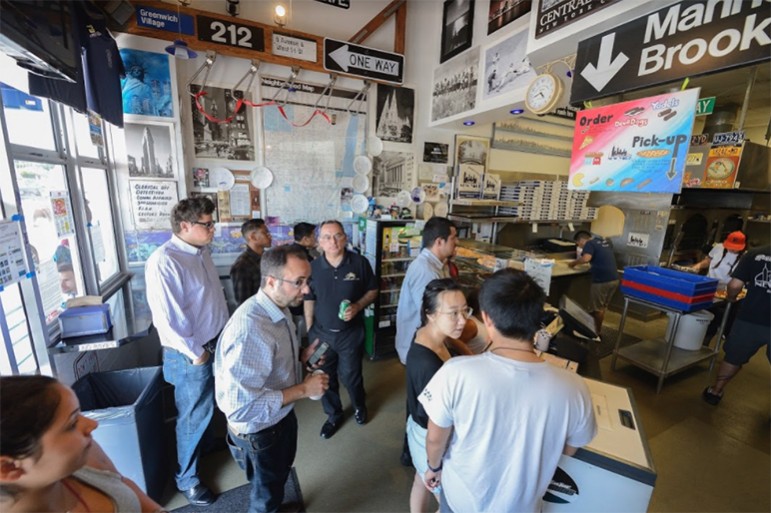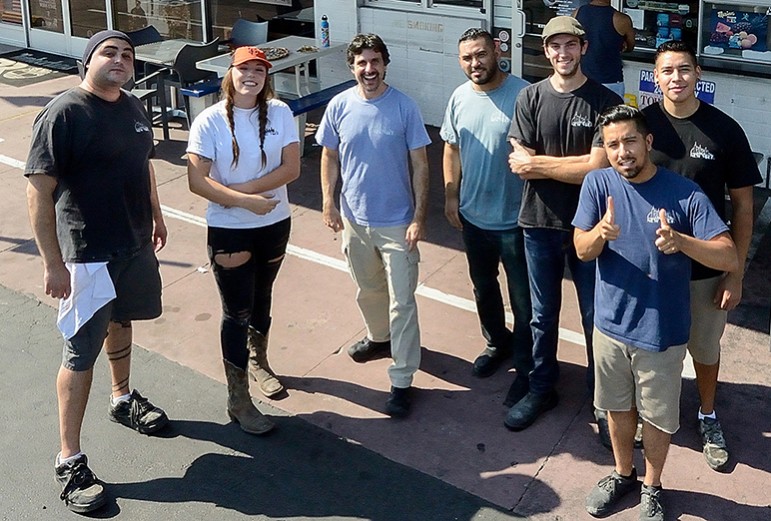The lunch rush at A Slice of New York looks something like a time-lapse video, preternaturally sped up but in sync. Behind the counter, workers fall into a frenetic pace, tossing dough, sliding pizzas in and out of four brick ovens, ringing order after order amid a crush of customers.
A recent expansion at the hole-in-the-wall eatery, located between a military surplus store and a longtime blues bar on Stevens Creek Boulevard, allowed workers to move a giant mixer and some shelves to a sequestered prep station. At the back of the house, there’s now considerably more elbow room to pound out the daily quota of about 200 dough balls and wind strips of it into hundreds of olive oil-brushed garlic knots.
“We have a lot more space now,” says Kirk Vartan, the pizzeria’s 51-year-old co-founder and general manager, as he makes his way to the back of the shop. “It used to be a little harder to not bump into each other.”
With more room, the pizza joint can improve efficiency and build capacity.
“If that’s what the employees decide to do,” Vartan clarifies. “That’s their call now.”
The physical renovations have set the stage for an existential one at A Slice of New York. Last month, Vartan, who co-founded the business in 2006 with wife Marguerite Lee, invited the workers to become equal partners in the company. Shilling pizzas is usually a starter job. But at A Slice of New York, it’s a path to becoming a business owner.
“Culturally, we’ve always been structured this way,” says Lee, 49. “So that really laid the groundwork for this next step in our evolution.”
Last month, the New York-style pizzeria became what may be the first brick-and-mortar business in Santa Clara County to turn its equity over to its employees. That’s one out of more than 163,000 companies that call the county home, per the U.S. Census Bureau.
“You don’t normally think of staying too long in the foodservice industry,” says Ren Boguiren, 28, a seven-year employee and one of 10 new owners. “But I’m very proud of it, honestly. When I get asked by people where I work, it’s not just, ‘I work at a pizza shop,’ it’s, ‘I’m a part-owner.’ That’s really empowering.”
Taped up over the prep area, a series of laminated illustrations of Lego Star Wars figures explain the new corporate structure of A Slice of New York, called ASONY for short.
“ASONY members define the rules, the procedures and the consequences—together!” reads one of the displays, which features a Lego Yoda, R2D2, Chewbacca and Han Solo.
Under the cooperative model, workers have a chance to become equal partners with the founders. Each of the pizzeria’s 30-plus employees have the option of becoming a member as long as they vest $3,000, which can be paid over two years out of payroll deductions after a 12-month candidacy period. Unlike stock, ownership ends when the employee quits, and all or most of the membership fee is refunded, depending on their length of service.
Each member has equal ownership and an equal vote in policy decisions. Worker-proprietors also divvy up profits at the end of the year.
“Initially we had friends and family come to us saying, ‘Why are you giving away your business?’” Lee says. “We told them, ‘No, we’re not giving it away, we’re sharing it. We’re trying to set an example for other businesses.”

This summer, A Slice of New York became a worker-owned cooperative. (Photo by Greg Ramar)
Finding Equity
Worker cooperatives in the United States date back to the advent of the labor movement in the mid-1800s when employees frustrated by a systemic lack of democracy on the job formed cooperative partnerships. But the business model appears to be seeing new life as workers and progressive-minded owners look for ways to combat the nation’s growing economic inequality.
“A worker cooperative is owned by everyone who wants to be part of it,” explains Hilary Abell, co-founder of the Oakland-based Project Equity, a nonprofit founded three years ago to help businesses transition to employee ownership. “The workers vote for the board of directors. The workers have control over the big-picture stuff, like policy changes. In a traditional ownership model, employees live with the results of decisions they had no part in making.”
Though rare in the U.S., worker co-ops claim a long pedigree in Europe. In northern Italy’s Emilia Romagna province, about two out of every three inhabitants are co-op members who generate a third of the region’s gross domestic product. Spain’s Mondragon Corp. is a federation of hundreds of cooperatives founded in 1956. A young Catholic priest, José Maria Arizmendiarrieta, formed the alliance to help a Basque town recover from the poverty and devastation of the Spanish Civil War. By the end of 2015, it employed more than 74,335 people in 257 companies.
Meanwhile, only about 400 American companies operate as employee co-ops, according to the U.S. Federation of Worker Cooperatives. That figure doesn’t count other types of cooperatives, including those run by producers and consumers, which would bring the figure to 30,000.
From coast to coast, there are worker-owned thrift stores, brewpubs and internet-hosting companies. Taxi drivers squeezed out by Uber and Lyft are trying to disrupt the industry that disrupted theirs by rolling out a cooperatively owned ride-hailing app.
Abell says there’s been an uptick in new worker-led cooperatives and heightened interest in the model since the Great Recession.
“There’s a lot of evidence that shows cooperative businesses survive longer in their industries,” she says. “They can be more profitable, definitely more equitable and they tend to pay higher wages.”
They also offer a way for companies to preserve their legacy, which is a growing challenge with a looming “silver tsunami” of baby boomer retirements.
A report released earlier this year by Project Equity found that boomers—those born roughly between 1946 and 1964—own nearly half of privately held U.S. businesses with employees, with an aggregate payroll of $1 trillion. But they’re retiring at unprecedented rates. Government estimates put the figure at 4 million retirements per year.
In the nine-county Bay Area, roughly 65,000 businesses are owned by people of retirement age, according to estimates based on U.S. Census Bureau data. Together, they employ about 626,000 people whose labor generates $150 billion in annual revenue.
Yet more than 85 percent of business owners have no succession plan, according to the U.S. Small Business Administration. Only a small fraction of owners pass their company on to family, Abell says, leaving companies at risk of closure or getting sold.
“It’s far more likely that the company shuts down,” she says.
Buyouts often translate to layoffs, Abell adds, which concentrates power into fewer hands. Ownership handoffs can also fundamentally change the character of a business and its stake in the community. Small businesses, which make up 99.7 percent of all firms and provide 48 percent of jobs nationally, disseminate three times more money into the local economy than absentee-owned or chain corporations, according to a 2012 survey by national research firm Civic Economics.
“Cities put in a lot of effort to bringing in new corporations, promoting startups and things like that to build their tax base,” Abell says. “But there’s very little attention being paid to this huge loss of business from the retirements, or the deaths, of business owners.”

Kirk Vartan quit a career in tech to open his popular New York-style pizeria, A Slice of New York. The business now has shops in San Jose and Sunnyvale. (Photo by Greg Ramar)
Risky Business
Vartan, a native Manhattanite, found his way to Silicon Valley through the tech sector. As an IT technologist at Cisco, he met Lee, who worked in the company’s philanthropy division. After a couple of decades as a corporate apparatchik, Vartan opted out in 2006 to open A Slice of New York.
“We started out with less than six people,” says Lee, who co-founded the pizzeria but held down her day job at Cisco for another seven years while working nights and weekends with her husband. “It was nutty at first. At the time, we were just at that little San Jose shop. We had no set hours, so we’d stay open really late. It got a little out of control sometimes.”
Lee had reservations at first. Vartan had the drive, but no experience in the foodservice industry.
“Just making his dream happen was important to me,” Lee says.
Though the couple founded the pizza parlor as a sole proprietorship, the goal was always to transition to some kind of employee ownership.
“When we first started, our corporate attorney said, ‘Don’t even offer that. You’re going to set expectations really high, unreasonably high,’” Vartan says. “He told us, ‘You risk getting ripped off, people will steal from you, you’ll have high turnover, it’ll ruin the company.’ We didn’t have any experience with this, but we were like, ‘OK, that’s interesting information, we don’t really care, we’re going to do it anyway.’”
Vartan made himself general manager and assigned shift leads, a purely operational hierarchy to keep things on tempo at the flagship store on Stevens Creek Boulevard and the second location in Sunnyvale. They also offered bonuses and performance incentives.
“Over half the people that work for us, they never had a bonus before,” Vartan says. “For some of them, when they first got it, they were like, ‘Why are you giving us this money?’ It was totally new to them.”
About two years ago, Vartan and Lee began talking about actualizing their cooperative culture as a legal entity. They shelled out some of their own money for attorneys, accountants and Project Equity’s guidance. This summer, they made it official. They appraised the business and sold its assets to the new entity for a note, which Vartan expects to pay off within six years, based on expense and profit projections. If the co-op exceeds expectations, the selling entity gets an “earn out” above and beyond the loan payments.
They structured the loans, licensing and royalties based on what the business could afford, on its past performance and to create a successful model to evangelize. “This is a 100 percent transparent process,” he says. “Everybody sees the books. If any aspect is one-sided, the model breaks down.”
Other worker-ownership structures, by contrast, eschew democratic decision making. Employee-owned stock options (ESOPs), another worker-owned model, appoint trustees to manage a benefits plan that pays out on retirement. Employee stock option plans, popular in Silicon Valley, offer upside if a company prospers but give employees little voice in company governance.
“We’re trying to figure out a way to create wealth in this area that isn’t tech based,” Vartan says, “to take that Silicon Valley startup mentality in the service industry.”
To protect the integrity of the brand, Vartan and Lee kept the recipes and logo trademarked under a separate company, which costs the co-op a modest licensing fee. Unlike a franchise, Vartan says, the cooperative has a right but no obligation to buy products from the licensor, and can expand the number of locations if it so chooses.
On July 31, A Slice of New York held its inaugural board meeting at Vartan and Lee’s house, with a videoconferencing setup for members who couldn’t attend in person. The discussion covered the shop’s half-hour break policy and legal contracts. Members appointed officers and celebrated their new partnership.
A common misconception is that co-ops eliminate rank. While some do, it’s often practical to maintain certain management roles and hierarchical divisions of labor. At A Slice of New York, the day-to-day business will function just as it did before becoming a co-op. But the big-picture planning is now a group effort.
“A part of me feels like I’m not qualified to take on this role,” says Sahm Joushanpoosh, 34, who was elected chairman of the board. “But that’s part of the evolution of our transition, we have to learn as we go.”

There’s more space in the back after some changes to the San Jose pizzeria, but customers willingly cram into ASONy for the daily lunch rush. (Photo by Greg Ramar)
Adjustment Bureau
Cooperatives have a rich history in the Bay Area, where they grew out of the countercultural movements of the 1960s. Rainbow Grocery opened in San Francisco’s Mission District more than four decades ago. Across the bay, the 50-year-old Cheese Board Collective—made up of a cheese shop and a pizzeria—has become an iconic presence in Berkeley’s “Gourmet Ghetto,” home to Chez Panisse.
Twenty years ago, the Cheese Board Collective lent its expertise and financial resources to launch the Arizmendi Association of Cooperatives, which took its name after the Spanish priest who founded Mondragon. Today, there are six Arizmendi bakeries in San Rafael, Oakland, San Francisco and Emeryville.
According to the Network of Bay Area Cooperatives, the region is home to about 60 worker co-ops—and counting. Two summers ago, NanoFarms USA, a sustainable garden in Palo Alto, converted to an employee cooperative. Niles Pie Co., a mom-and-pop bakery in Union City, made the switch earlier this year.
In the South Bay and Peninsula, only a handful of companies operate as employee collectives. Emma’s Eco-Clean in Redwood City was founded in 1999 by predominantly Spanish-speaking women who wanted to take charge of their own careers.
Today, the business has 27 female co-owners and more than 2,600 clients. A sister company, Eco-Care Professional House Cleaning, launched in 2002 out of Morgan Hill. Both spun off from Oakland-based nonprofit Prospera, which helps mostly low-income Latina immigrants build their own businesses.
Sunnyvale-based TeamWorks, another worker-owned cleaning company, and its sister gardening company, TeamWorks Sustainable Landscapes, grew out of that same ethos.
“One of the underlying issues that cooperatives seek to change is a lack of democracy in the workplace,” says David Smathers Moore, a Los Altos native and former labor organizer who helped get TeamWorks off the ground in 2006. “A lot of people aren’t used to that, so it has been a learning process for us.”
Moore took an interest in worker-run businesses after seeing the devastating effects of globalization on largely African American and Latino blue-collar communities in Chicago, where a generation of deindustrialization gutted the middle class. In 2001, Chicago lost its standing as the candy capital of the world when Brach’s Confections closed its West Side plant. As a nonprofit community organizer, Moore worked with local labor groups to deal with the closure, which resulted in 1,100 layoffs.
“It was devastating to these communities,” Moore says. “Here you have the largest candy plant in the world—which provided good-paying blue-collar jobs for decades—close without anyone who worked there having a say in it. You have a company making all its decisions in Zurich, and nobody who worked at this place had any opportunity to say, ‘We understand that we’re losing money here, but we can do this, and make this cut and this sacrifice, and we can do this together.’”
Instead, people who labored at the factory for their entire adult lives were given a month’s notice.
“It seemed like we were always fighting a losing battle,” Moore says.
When he returned to the South Bay a few years later, he came with the intent of forming a business without a boss.
With little background in entrepreneurship, Moore learned the ropes with his new partners, a collective of Spanish-speaking immigrant women. Most of them had experience in the cleaning business, which Moore had to learn in the field.
“I had to establish my credibility with the workers, which meant cleaning homes and learning about the products firsthand,” he says. “From there, it was all of us figuring out how to run this together, learning about accounting and marketing, about how to resolve conflicts and other day-to-day decisions involved in owning your own business.”
For several of the women, it took an adjustment period to realize the scope of their authority as worker-owners.
“We don’t live in a culture that gives workers that kind of agency,” Moore says. “Especially for people who have been marginalized their whole lives, and who carry all that stress and trauma and internalized oppression, it takes some adjustment to undo those effects by gaining the confidence, skills and experience. One of the benefits here is that there’s such an opportunity for personal and professional growth.”
One criticism of co-ops is that they take too long to make decisions. Personality clashes can lead to squabbling over what a new uniform should look like or whether to buy a company vehicle or bring a new member on board.
“That’s democracy, though,” says Sue Lopez, a part-owner of the Arizmendi branch in San Francisco’s Mission District. The alternative under a traditional corporate structure would be to accept unilateral edicts from on high, she notes.
While collective decision making could mean bickering over minor details, Moore says, it also means weathering tough times together. When fallout from the economic downturn struck in 2008 and 2009, the employees voted to each take a 15 percent pay cut rather than shrink the staff.
“No one even considered layoffs,” Moore says. “They decided to share the pain.”

A Slice of New York employees now go by a new title: business partners. (Photo by Greg Ramar)
The Family Crest
Lee and Vartan, who have no kids of their own, consider the pizzeria a family business and labor of love. Workers turn to the couple for personal advice and invite them to weddings and graduations. It’s not unheard of for them to close up shop for a day to attend a milestone event, or so employees can race in a Tough Mudder together.
“It may sound crazy to people who don’t know the way we operate,” Joushanpoosh says. “But they’ve always treated us as peers. Most bosses try to demand your respect, but Kirk and Marguerite go out of their way to earn it.”
ASONY gave Miguel Rubio his first job. He was 17 at the time and self-conscious about his stuttering, which kicked in under stress.
“Kirk and Marguerite would take it upon themselves to get me to speak up,” says Rubio, who worked on and off for the pizzeria over the next 11 years while working toward becoming a first-generation college graduate. “That’s where I found my voice.”
Last week, Rubio packed up for Austin, Texas, where his girlfriend will attend grad school and where he’ll try to find a job with a similar culture to ASONY’s. Before he left, he went under the needle to get the company’s logo etched on his arm.
They call it the “family crest”—a black silhouette of a New York City skyline bordered by the outline of a pizza slice and the name of the business, A Slice of New York. About a dozen other employees have it inked onto their skin. Joushanpoosh has yet to get one, but he considers the burns on his arms a mark of dedication.
“We’ve seen tremendous growth here,” Lee says. “We joke about how we’re all here on the island of misfit toys. We came here kind of randomly, yet we became this family and supported each other.”
The least she and Vartan could do, she says, is to share their legacy.
“We always wanted this to be kind of like a family business,” Lee muses. “Now, in a big way, it really is.”


This is a very nice and heartwarming story. I’ll have another slice. :)
Free people deciding how to live thier lives and what to do with thier property, sounds like liberty.
How did this article get past the editors? This is down right subversive to the collectivist narrative.
Interesting concept. It will be even more interesting if it works, and I really wish them the best of luck.
But while they’re getting new business cards printed, I have a question or two: the article states that last month they became what is probably the first brick-and-mortar business in Santa Clara County to turn its equity over to an employee collective. Here’s a question: as one business out of more than 163,000… do they know something that the other 163,000 don’t?
Human nature is arranged very efficiently. Our organizations require a headman (or *sigh* a headwoman). That’s why the cultures, companies, and communism that don’t have one individual at the top consistently fail. Either they have a headman by another name, or the ones with a headman eat the lunch of organizations without one (1) clearly defined leader (AKA: “the Boss”; “el Jefe”, etc).
Furthermore, that organization’s single leader must be given all the tools. He can’t be authorized to just hand out participation trophies, he must also be authorized to administer spankings—’up to, and including termination’, as they say.
Far more than any other factor, companies succeed or fail due to the quality of their leader (not leaders, plural). Amazon wasn’t just in the right place at the right time; lots of other companies were, too. But Amazon succeeded spectacularly because of the guy at the top: Jeff Bezos. And lots of companies were producing steel, but only Andrew Carnegie out-competed them all (and ruined almost all the rest). And Apple was on the rocks, foundering—until it brought back Steve Jobs.
There are thousands of similar examples demonstrating why some companies succeed, and others fail. In the end, it always comes down to the individual at the top. Companies run by leadership committees (or even those run by two Co-CEO’s) are routinely out-competed by companies run by an individual. It’s the way human nature is arranged, see? It’s what works best.
So this ‘new’ hierarchy is simply camoflage for a traditional company with a boss. With ONE boss. Without a decisive guy at the top it may manage to stay in business, but it won’t excel in the marketplace. It won’t become another U.S. Steel, or Amazon, or Apple. That is only accomplished by companies with a single headman.
And what happens to the company when the top guy is replaced, which will happen sooner or later? Remember what happened when Jobs was replaced by Chambers?
But let’s say their New Age language works, and although they pretend that everyone is equal, in reality they have a headman/CEO who can hire and fire, reward and discipline. OK, that might work. But if it does, it’s because of their hierarchy is really no different than a traditional business. And the more like a traditional businesses its actual hierarchy is, the more likely it that will succeed.
So why not dispense with the fake titles, and just institute a profit sharing plan? IMHO, this proposed “new” management style uses touchy-feely Esalen/Age of Aquarius bunkum to cover up the fact that it’s a company with a traditional org chart, including a head honcho (and since I have no skin in the game [ie: my own money] this is just an opinion from the peanut gallery—worth the price of admission, but not much more).
Lots of companies have profit sharing plans. They can be anything from a little bit of company stock in a 401-K, to substantial company ownership, to full and equal shares in the company, as explained in this article. There’s nothing new under the sun when it comes to profit sharing plans. What’s new is the language being used. George Orwell would have understood.
A while back Kirk put flyers around the neighborhood warning people about a dangerous employee he’d hired. There were pictures of the guy on it, and people were encouraged to call the cops, IIRC. So, what happens when there’s a maniac employee like that? Does he get voted off the island? And if that happens, will he lawyer up? What do you think, when company profits are being passed out to the survivors? See, there’s a reason that companies are set up the way they are.
Like I said at the beginning, I sincerely wish them well, and I mean it. I hope they’re all financially successful in their new venture. But if this new organization succeeds, it won’t be because they’ve discovered a new and superior way to run a company. It will be because the individual at the top is given the same management tools as competitors with one CEO—and because the guy at the top is a better businessman. In other words, because the boss is better at turning a profit than his competitors.
Good luck, people. And have fun with those business cards!
One of the most successful organization in the world, the U.S. economy, has no one captain but many independent actors. Another organization, the Internet, was built to not have a central point of failure. Not to mention the natural systems that have no “boss” but are at work every day. Seems to me decentralized systems can work just fine.
Ahhh an anachro-syndicalist… I’m cool with the commune as long as you don’t force me on it or expropriate my plot of earth.
Mr Chomsky tried it with a publishing company, had to sue to get out of the deal, ugly scene. Wish it worked, but too many people have the slave mentallity.
Nice story, but where does the ship with 10 capitan’s sale to every day?
Towards excellence? Cooperatively-owned pizza makers consistently are voted some of the best in the country. Cheese Board, Arizmendi, ASONY, all highly ranked: http://hoodline.com/2017/08/a-slice-above-how-san-francisco-ranks-among-america-s-50-best-pizza-spots
But how do we know that none of the employee/owners of A Slice Of New York are members of or have associations with any white supremacist groups or question whether confederate statues should be torn down or are friends with someone who thinks they shouldn’t be torn down?
Better run background checks on all of them so these subhumans can be identified and fired thus reassuring progressives that they can eat pizza there with a clear conscience.
John, as long as you don’t participate in a demonstration that is in large part constituted of people with Nazi symbols, you’ll be fine. If you need help identifying Nazi symbols, ask a friend.
It was just by pure luck that the Top Dog employee happened to be spotted and thankfully he was fired. But since our nation is under imminent threat from neo Nazis and innumerable other groups of white people can we really afford to rely on dumb luck to root them out?
BTW- Are you related to Dan Quayle?
I don’t think we’re under imminent threat, doesn’t mean it’s not a good idea to fire Nazis if you are currently paying them money! I hope the different is easy for you to understand.
This sounds nice, but they still can’t afford to live in one of the high-density apartments that Kirk loves to promote.
They sure as hell are closer to afford a high-density apartment than a low density apartment.
> Mondragon Corp. is a federation of hundreds of cooperatives founded in 1956. A young Catholic priest, José Maria Arizmendiarrieta, formed the alliance to help a Basque town recover from the poverty and devastation of the Spanish Civil War. By the end of 2015, it employed more than 74,335 people in 257 companies.
A corporation in a small town that owns 257 companies and employs 74,335 people?
Sounds like a “company town”.
I thought a company town was a bad thing, not a good thing.
High density Apartments typically cost much more as they are newer and designed for professionals. There is not many affordable high density apartments due to most of the municipalities not investing in affordable or low income housing. Most of the builders don’t care, they are trying to maximize their profits.
That has nothing to do with density and everything to do with amenities together with the supply and demand of apartments in the market. Everything else being equal, high density is cheaper to build, cheaper to connect to utilities, easier on traffic, better for retail, etc.
Actually, it does have to do with density. Back in the 50s and 60s, building 5/6 unit multifamilies on 10K-12K sq ft lots made sense. Now, that would be crazy as you need to make way more money on that footage, maybe townhomes, but not apartments. Apartments now need large swimming areas, exercise rooms, party rooms, and to amortize that cost, they need to make a lot of units.
Developers have every right to maximize profits and seek amendments left and right. It’s up to city councils and residents to voice concerns and make sure the city is not taken advantage of with inappropriate general plan amendments. What’s sad is over the last couple of years Kirk Vartan has glossed over concerns, waving the flag of placemaking and community benefits (even claiming a sign pointing to a rooftop garden on a 20 story building as a win). He wants to bring a “slice of New York” to Santa Clara and urbanize the place, even though he doesn’t live here.